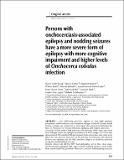Persons with Onchocerciasis-associated Epilepsy and Nodding Seizures Have a More Severe Form of Epilepsy with More Cognitive Impairment and Higher Levels of Onchocerca volvulus Infection
View/
Publication Date
2020-06Type
Article, Journalviews
downloads
Metadata
Show full item record
Abstract/
Aims. Following previous reports of very high epilepsy prevalence in the onchocerciasis-endemic villages in Maridi County, South Sudan, a study was conducted to investigate the association between the level of Onchocerca volvulus infection, epilepsy, and related outcomes. Methods. In December 2018, persons with epilepsy (PWE) were recruited from villages where an epilepsy prevalence of 4.4% (range: 3.5-11.9%) was documented. We enrolled 318 participants from whom two skin snips were taken for microscopic detection of O. volvulus microfilariae (mf). Seizure history was obtained for all PWE and their degree of disability assessed using the modified Rankin scale. Results. Almost all (84.9%) PWE had detectable mf in their skin snips. Onchocerciasis-infected PWE experienced nodding seizures more often than uninfected PWE (p=0.034). Moreover, persons with nodding seizures had more frequent seizures (p<0.001) and higher disability scores (p<0.001), and were more often cognitively impaired and younger at the time of their first epileptic seizure (nine years vs 12 years, p<0.001) compared to PWE without nodding seizures. Based on multivariate models, nodding seizures were associated with higher mf densities (aOR: 1.022; 95% CI: 1.005-1.041). Epilepsy onset at a younger age was associated with a worse outcome. Higher frequency of seizures, longer duration of epilepsy and younger age were associated with increased disability. Regular antiepileptic drug use was associated with better cognitive and disability outcomes. Conclusion. PWE with nodding seizures have a more severe form of onchocerciasis-associated epilepsy, with earlier seizure onset and higher levels of O. volvulus infection. Younger PWE were prone to worse epilepsy outcomes, which would be prevented with regular antiepileptic treatment.
Subject/
Onchocerciasis; Epilepsy; Nodding syndrome; Microfilariae; Disabilities; Seizures; Seizures; South Sudan
Publisher
Epileptic DisordersCollections
- General - GEN [367]

